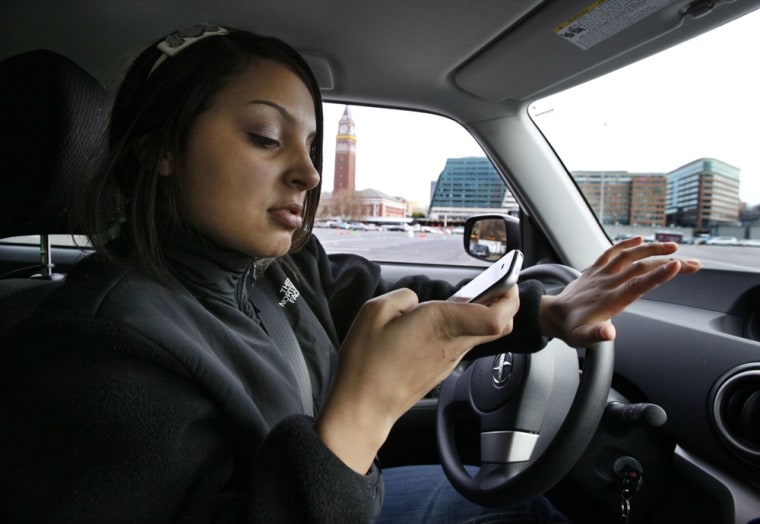When a dump truck carrying 24 tons of rock salt crashed on I-81 in Pennsylvania recently, police linked the collision, which killed one motorist and injured several others, to distracted driving.
The incident is not unique. A quick search of news headlines for car accidents shows federal regulators linked texting, cellphone use and other forms of distracted driving to 5,500 deaths in 2009 — the latest year for which data is available — and to at least a half million injuries.
“Distracted driving has become a deadly epidemic on America’s roads,” insists U.S. Department of Transportation Secretary Ray LaHood, the country’s leading — and perhaps most outspoken — proponent of rules that would bar drivers from texting, making cell phone calls or using other high-tech devices while behind the wheel of a vehicle.
Such measures have already been enacted in a number of states across the country. But activists believe these steps don’t go far enough. Some would go so far as to even bar the use of hands-free Bluetooth cell phones, and even some technologies that claim to improve driving safety.
Critics — and not just those involved in the automotive industry — contend that LaHood and his allies are going too far. They question some of the more frightening claims about distracted driving, and they point to the latest federal data showing that, if anything, the number of traffic fatalities has actually fallen quite sharply even as the use of supposedly distracting technologies has risen dramatically.
“If cell phones and all the other new technologies are so dangerous, why aren’t we seeing carnage on the highways?” asked Aaron Bragman, an automotive analyst with the consulting firm IHS. “We’re not. The number of highway fatalities is lower than it has been in years.”
The reality is that both sides do agree on some key issues.
“There’s no disagreement about texting, which is not conducive to safe driving,” emphasized Louis Tijerina, a senior technical specialist with Ford’s advanced engineering department.
Automakers have also come to support — or at least accept — efforts to restrict the use of handheld phones behind the wheel. Some might suggest that’s driven, at least in part, by the profit motive, since it encourages new car buyers to purchase Bluetooth hands-free calling options.
Indeed, Ford credits its voice-activated Sync system with helping generate a significant amount of sales. The technology can program everything from the radio to the navigation system through a touch screen by using steering wheel-mounted controls, or by using your voice.
But despite the carmaker’s claims that the latter method sharply reduces driver distraction, Consumer Reports recently pulled several Ford products — notably the Ford Edge and Lincoln MKX crossovers — off its influential Recommended Buy list, insisting their systems were “overly complicated and distracting.”
The magazine isn’t alone in worrying about Bluetooth systems and new voice-activated technologies. A 2006 review of more than 100 experimental studies by the Insurance Institute for Highway Safety found plenty of reason for concern.
Former law officer Jack Peet, now AAA Michigan’s Group Traffic Safety Manager, is among the skeptics.
“People often tell me they’re multi-taskers, but driving itself is multi-tasking,” he warned, adding that this is another way to take your attention off your driving.
Peet even questions many of the new technologies designed to improve safety. Active Cruise Control — which uses laser or radar to keep your car running at the same speed as the traffic ahead — encourages motorists to take their eyes off the road, Peet argued. And blind-spot detection systems — which look for traffic you might miss changing lanes — makes drivers lazy, he added.
Some auto industry officials agree that technology can have its downside. When Volvo added the City Safety system to the XC60 crossover the automaker was worried that motorists might think this auto-braking technology could let them focus on things other than driving.
So Volvo made sure that whenever the system kicked in “it would do so quite abruptly,” explained Volvo spokesman Dan Johnston, so “it’s not something you want to depend on to stop your car normally.”
Nonetheless, critics counter the assertion that any form of new technology is a highway menace. Ford’s Tijerina questions whether it’s really more dangerous to be using a voice-controlled navigation system instead of relying on old-fashioned maps, “or simply driving around lost and confused.”
He also cautions that many distracted driving studies don’t reflect real-world driving conditions.
“They tend to bias things … to make it very, very difficult,” Tijerina asserts. “Out in the real world people don’t [face] the same level of demand required in these lab and simulator studies,” and they are more likely to take appropriate steps to further reduce risks — like slowing down while dictating an address.
The critics cite studies of their own. There are preliminary reports showing little to no change in accident rates when the use of handheld phones is banned. And the critics routinely point to the highway death toll data to question whether technology is having any impact.
Figures released by the Department of Transportation last autumn recorded 33,808 traffic fatalities for 2009, a 10 percent drop from the year before, despite the fact that motorists drove more. Yet Transportation Secretary Ray LaHood cautioned “it’s not an excuse to rest on our laurels.”
Indeed, if it wasn’t for today’s better-designed cars, improved roadways and specially-trained emergency response teams, “We’d be seeing a significant increase in fatalities,” insists the AAA’s Peet.
How much of a distraction is safe — or at least tolerable — and which technologies enhance or worsen driver safety will likely remain a debate for some time. But with the exception of in-car texting, analyst Bragman doesn’t expect to see major changes in current laws.
LaHood and his supporters, he cautioned, “don’t have the support in Congress, especially with Republicans in control. There isn’t any interest in more regulations.”
